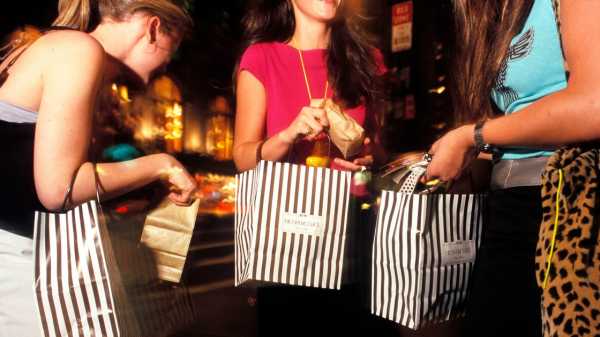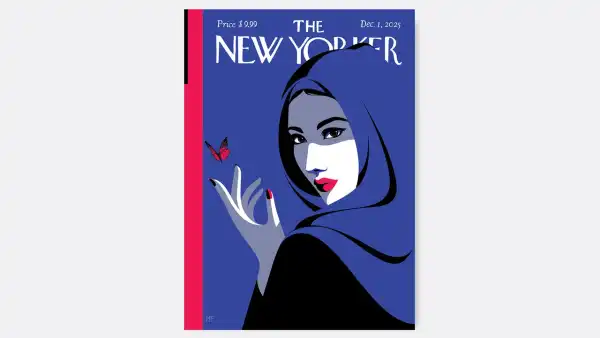
I was not born a Bendel’s girl. Raised in a middle-class household thirty minutes north of Manhattan, I was weaned on malls—strip malls, outlet malls, underground malls. If I associated upscale department stores with anything, I associated them with food. Neiman Marcus was where my grandmother took me for popovers with strawberry butter. Bergdorf Goodman in the city was for my mother’s friends who lunched. The men’s store across the street was for the savvier women who wanted to eat their chopped salads in peace. Henri Bendel didn’t serve food, and so it wasn’t on my radar.
I was in middle school the first time I went, escorted by a wealthy friend and her mother. I remember gazing at the frosted Lalique windows, the high ceilings, the curved landings that gave the place the feel of a nineteen-fifties musical, or a nineteen-nineties musical—any musical in which a winding brass-railed staircase is meaningfully descended. The stairs themselves were covered in plush carpeting at the base, which, in the middle of Manhattan, suggested a truly jarring level of public trust. Overhead, striped lampshades crowded around chandelier bulbs as if warming themselves by a fire. Unlike every store I’d ever been to, the décor of Bendel’s did not seem to correspond to the cost of the merchandise. It was too welcoming, too bohemian, too whimsical. Gasping at price tags was part of the shopping process. This design tactic strikes me as borderline nefarious now, like packaging real cigarettes in candy colors. But, as a kid, all I knew was that Bendel’s looked like it belonged to Willy Wonka’s mistress and that I wanted to live with her.
When I got home, I regaled my mother with stories of retail Xanadu. She cocked her head and blinked at me, trying to decide whether she had failed to tell me about this famous place or I had forgotten. Bendel’s was founded in 1895. It was the establishment that introduced makeup trials to consumers. (We can hold it responsible for the overzealous perfume lady rom-com trope.) It introduced Coco Chanel to America, and, in the sixties, Andy Warhol to a steady paycheck, as an in-store illustrator. It’s a pop-culture darling, too. I clocked it most recently in the first season of “The Marvelous Mrs. Maisel.” Miriam Maisel’s husband has taken up with another woman, but, after he and Miriam reunite for an evening, she tracks Miriam down at her day job, working the makeup counter of B. Altman, apparently intent on telling Miriam off for having stolen her own husband back. The woman rattles off all the department stores she checked first. Saks. Bergdorf’s. Macy’s. Gimbels. Lord & Taylor. She practically spits the word “Bendel’s,” adding, “even though I thought, She wouldn’t shop at Bendel’s.” The line is meant as a jab, but it also belies Bendel’s role as a midtown outpost for downtown cool. Bendel’s was aspirational for many middle-class Jews, but it was not a place to find a truly rich, conservative Upper West Side gal like Miriam Maisel.
Bendel’s soon became part of my nascent fashion consciousness. When preparing to go off to college, my sole wardrobe purchase was a Bendel’s-brand sweater set. I still have the cardigan, which is made from cashmere so thick you could carry water in it. But it wasn’t until my junior year at Columbia that I devised a means of spending more time there than any customer in its history. As an anthropology major, I decided that I was going to blow the lid off New York class structure through the prism of the city’s bathrooms. Yes, bathrooms. I stood, for hours at a time, in restrooms across the city, including and especially the bathroom at Bendel’s. Ostensibly, I was there to observe wealthy ladies, to see how they looked at themselves in the mirror and how they interacted with me. (One of them asked me to confirm the presence of a bunion on her foot.) In truth, I had come because the Bendel’s bathroom was a more pleasing place to pass the time than my dorm room. I spent entire afternoons in that ladies’ room, sitting on a velvet banquette beneath the regal jungle-scene wallpaper, reading bad novels, scribbling in my notebook, waiting for revelations that never came. After graduation, working as a publicity assistant at HarperCollins, on Fifty-third Street and Fifth Avenue, I would take breaks in Bendel’s when it was too cold to walk in the park. The closest churches were too intimidating, the closest museums were too time-consuming, and Bendel’s made me happy. No other hue of shopping bag, neither Cartier crimson nor Barney’s black, evoked the same curiosity as the Bendel’s brown and cream.
Alas, what I’m describing no longer exists. Eight years ago, Bendel’s ceased selling apparel in the store. Four years ago, they quit selling third-party merchandise altogether, transforming the hallowed space into a scattershot funhouse of Lucite clutches, statement necklaces, and window decals. It was no surprise to learn, this past September, that, in January, Bendel’s will shut its doors. Those with longer memories might argue that the store began its downward spiral back when it shifted locations and renovated, in 1990, or in 1985, when the store was acquired by L Brands, the owner of Victoria’s Secret. Perhaps I’m falling into the interloper’s trap, wringing my hands over the shuttering of a Shake Shack when I should be wringing my hands over the closing of the shoe-repair place that came before it. But the “new” Bendel’s is the only one I knew. And now? I hardly know ye, either.
On a recent visit, the top two floors were closed, blocked off with a rope, the remnants of a Rent the Runway display visible from below the balcony. The place still smelled of moderately expensive perfume, but piles of cardboard packing boxes and crumpled packaging were locked behind glass doors. Everything was on steep sale. The restroom floor was dirty and looked smaller to me now, as if I had read my novels there at age ten, not twenty. I spotted a paper sign taped next to the Lalique windows on the upper floor, asking readers to “pardon our appearance.”
There’s not as much public indignation over Bendel’s closing as there would be over, say, the demise of a beloved restaurant—perhaps because mourning the loss of any retail outlet in 2018 risks coming off as tone deaf, and perhaps because the store’s disappearance is not a harbinger of a changing neighborhood. Fifth Avenue will live, with or without Bendel’s. But, for those of us who grew up believing that the place was a symbol of fortunate and fashionable adulthood, those brown-and-cream stripes deserve a proper eulogy. Even in the mess of the store’s final days they remain omnipresent, running up and down the surface of every wall and every counter, narrow highways that carried me straight out the door.
Sourse: newyorker.com






